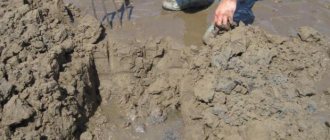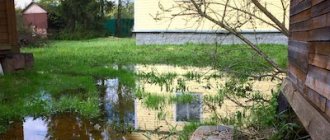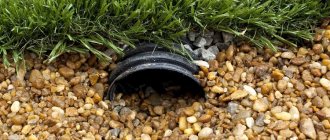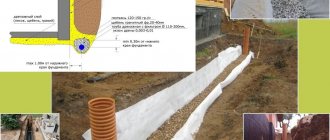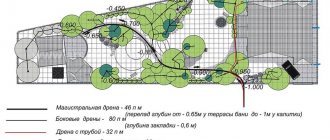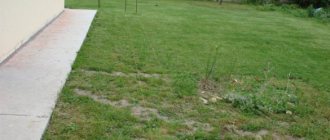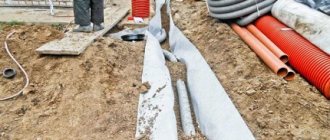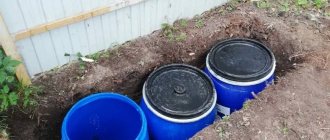Home > Articles > Drainage systems > Design of drainage systems
- Ask a Question
- Send a request
Drainage design standards are determined by guidelines issued by Moskomarkhitektura in 2000. This document describes the standards for drainage of buildings, structures, underground communications and does not apply to special-purpose structures, transport, and road facilities.
Drainage is required if:
- the lower level (floor) of a building or structure is below the groundwater level or exceeds this level by less than 0.5 m;
- on the construction site there is loamy or clayey soil, soil with capillary moisture;
- the technical underground floor of the house is buried lower than 1.3 m from the ground level in loamy or clayey soil.
Any drainage project requires the following mandatory work:
- backfilling of trenches, pits with soil cleaning and compaction;
- arrangement of outlets for the drainage system of the house. May be closed. Drains from open outlets are discharged into open trays;
- along the perimeter of the house - arrangement of a blind area 1 m wide with a surface inclined towards the outer edge;
- when entering and exiting underground communications through walls or foundations - hermetic sealing, waterproofing of holes in them;
- arrangement of linear drainage. For areas where the terrain or ground level does not allow organizing the removal of surface runoff by storm sewers, backfilling and grading of the territory are carried out.
What is drainage?
Drainage is a system that removes excess moisture from a building using a pipe structure. There is an opinion that to effectively collect water, only a blind area is enough, but experts in this field recommend installing a full-fledged drainage system, which allows for much better protection of the building from the harmful effects of moisture.
No matter how beautiful the blind area is, it will not completely protect the house from moisture Source pinterest.at
A drainage system for a home can be of three types :
- Open . It is a structure where open type trenches are used as drainage drains, the depth and width of which is 0.5 meters. This is the easiest drainage option for self-installation. The disadvantages of such a system include the unaesthetic appearance, as well as the unreliability of the structure, which will require additional reinforcement of the walls with special trays;
- Zasypnaya . This is a structure where prepared trenches are filled with coarse crushed stone or rubble, and turf is laid on top. The advantage of such drainage is its long service life and ease of installation. In addition to the advantages, there are also disadvantages: low throughput, inability to carry out maintenance;
- Closed . This is done by laying drainage pipes with holes in the ground. This system is efficient and does not have the disadvantages of other systems. Its disadvantage is that the installation is quite complicated.
A closed drainage system is difficult to do correctly without certain skills and knowledge Source handmaster.ru
See also: Contacts of companies that specialize in the installation of water supply and sewerage.
Mistakes made when performing drainage yourself
Installing a drainage system without the participation of specialists is often accompanied by the following mistakes:
- The use of a wall drainage system to ensure the removal of excess moisture in areas with high groundwater levels;
- The use of pipelines in geotextile-type filters in areas with clay soil, which will ultimately lead to their clogging;
- Application of levels during pipeline laying;
- Installation of stormwater wells where drainage wells should be installed;
The most common mistake is to install only one drainage system around the house. As practice shows, this is too little. It is necessary to install a drainage system that will drain water from the roof of the building into a special well.
Also, you should avoid using one pipeline for drainage and storm water around the house, since the drainage will not cope with its functions during rains, which will lead to flooding of the area. Overmoistening of the soil near the foundation can lead to its heaving during frosts, which in turn will have a detrimental effect on the foundation of the house, even to the point of complete destruction.
Soil heaving is one of the serious reasons leading to the destruction of a house Source martand.ru
To make storm drains, orange sewer pipes (designed for soil) and special wells are used where excess water will accumulate, which can later be used to water the vegetation.
Types of drainage systems
The drainage pattern around the house is divided into two main types :
- Superficial (violates the aesthetic appearance of the site);
- Deep (perforated pipelines are used).
Surface drainage
Surface drainage around the house is more affordable, simple and easy to perform all necessary operations. Such drainages cannot cope with groundwater and are used only to drain melt and rainwater. surface drainage systems exist :
- Linear . It is used to drain rain and melt water from the entire area of the site. Through trenches dug in the soil, water is drained into a special well, where it accumulates. Such channels are closed on top with decorative grilles;
- Spot . Used to quickly collect water from one source. This drainage is covered with a special metal grate to prevent clogging. All local points are connected by pipes to the main pipeline, which drains water into the drainage well;
Carefully closed points will not disturb the inhabitants of the yard and will not spoil the exterior of the house Source evkrov.ru
- Open . It is a system of channels and drainage trays designed to drain excess water. Its unhindered movement is ensured by a bevel in the trench at an angle of about 30°, directed towards the main trench or drainage well. The advantage of an open drainage system is its low cost and ease of performing the necessary work. Disadvantages include the destructibility of the trench walls and non-aesthetic appearance;
- Closed . The arrangement is similar to open drainage, except for the use of special trays with decorative gratings, which increases the service life of the structure and also improves safety;
- Zasypnaya . This type of system is used in areas with a small area where it is not practical to install open drainage. The arrangement of backfill drainage begins with digging a channel 1 meter deep (the slope should be directed towards the drainage well). The base of the trench is covered with geotextile, after which it is filled with coarse crushed stone or gravel. To give an aesthetic appearance to the site, the structure is covered with a layer of turf on top. Such drainage of the house and site has its drawbacks, including the impossibility of maintenance during operation without dismantling work.
This is what the backfill moisture protection scheme looks like Source vse-o-kanalizacii.ru
Deep type drainage
In places with high groundwater levels, or in properties with clay soil located in lowlands, a deep drainage scheme around the house is used. Systems of this type must cope with the removal of large volumes of water, so the arrangement process is accompanied by the use of perforated pipes, the diameter of which depends on the amount of liquid being drained.
How to stop groundwater in the basement
Basements are often used for technical rooms, underground garages, cellars, saunas or gyms. It is important to create a comfortable microclimate in the basement for people to stay, find equipment, store food and preserves.
Protecting the basement from groundwater is the main task when building a house. High humidity and water destroy foundations and underground structures, shorten the life of the structure, and contribute to the formation of mold and fungi.
Waterproofing the foundation and basement walls both outside and inside the building will help partially solve the problem of high humidity. It can be done using various materials and technologies:
- Fused or adhesive insulation with roll materials made on the basis of bitumen: Gidroizol, Bikrost, Stekloizol, TechnoNIKOL, roofing felt.
- Membrane covering made of PVC, TPO or EPDM profiled sheets, fixed to the wall using bitumen mastic or dowels.
- Penetrating impregnation from a mixture of cement-sand mixture with the addition of chemically active substances, aqueous solutions of silicate and organic resins. The most effective is a binary waterproofing system with step-by-step treatment of reinforced concrete structures with aqueous solutions of liquid glass and calcium chloride.
- Injection insulation is one of the most reliable methods of protecting foundations and basement walls from moisture. The technology for installing injection waterproofing is a labor-intensive process. Holes are drilled in the structures through which penetrating compounds are introduced into the mass: epoxy, methyl acrylate, polyurethane or microcement.
- Coating waterproofing is carried out with various mixtures:
- bitumen mastics AquaMast, Bitumast, TechnoNIKOL;
- liquid rubber based on bitumen and liquid latex;
- liquid glass based on silicate mixtures;
- deep penetration compounds such as Penetron, Aquatron, Ceresit.
Coating materials are easily applied using a brush or brush. They create a durable film that reliably protects against moisture penetration and is resistant to mechanical stress. Prevents the development of mold and microorganisms.
Figure 6. Coating waterproofing of the basement.
Waterproofing foundation structures and basement walls is only partial protection of interior spaces from moisture.
To get long-term results, it is necessary to eliminate the cause of flooding and water penetration into the basement by building a reliable and functional drainage system.
The cost of installing turnkey drainage systems
Hiring specialists allows you to avoid many mistakes when arranging a drainage system. There are many companies on the market that provide drainage installation services, including project development and carrying out all the necessary work. The average cost of such services is 2300-5000 rubles per square meter and a depth of 1 to 3 meters, respectively.
Also, additional services may be offered, which are paid separately:
- Laying a pipeline for a storm sewer system. The cost of laying pipes to a shallow depth on average reaches 1,000 rubles per linear meter, and laying to a freezing depth is available at a price of about 1,800 rubles;
- The cost of manufacturing a manhole depends on the installation depth and reaches approximately 7,000-10,000 rubles for a recess of 1.5-3 meters, respectively;
When connecting pipes to a manhole, it is important to ensure that the joints are tight Source saratov.tiu.ru
- Installation of a storm drain is available at an average price of 4,000 rubles.
Important! It is better to sign contracts for the installation of turnkey drainage systems with trusted companies that provide a warranty period, which should be at least 3 years.
The price for drainage installation is cumulative and depends on the following conditions:
- Area of the site (cost calculation depends on the length of the canals);
- Complex of necessary works ;
- Slope angle (height between the top and bottom points of the trench);
- Soil type (work on wet clay soil is more expensive than work on regular soil);
- Groundwater level (deep drainage is more expensive than surface drainage).
Light pit in the basement
For natural lighting of basement floors, windows are often installed below ground level. To do this, recesses are constructed in the ground near the outer wall of the building and light pits are equipped.
Such structures serve certain purposes:
- protecting windows from contamination: debris, fallen leaves, snow;
- additional natural ventilation devices;
- restrictions on space in front of windows.
Pits can serve as technological openings through which various equipment and large items are supplied to the basement;
Light pits are installed both in residential buildings and in commercial and industrial buildings. They can be of various shapes: semicircular, square, rectangular and trapezoidal.
The modern construction market offers a wide selection of ready-made structures for constructing pits.
Pit housings can be purchased from, which is a distributor of the global manufacturer of surface drainage systems ACO (ACO Drain Passavant GmbH).
The products are presented in 14 standard sizes: from 80×60 to 150×200 mm, depth from 40 to 70 mm.
Figure 7. Light pit design.
Table of standard sizes of ACO light pits.
| Pit body depth (mm) | Pit body width (mm) | Pit body height (mm) |
| 40 | 80 | 60 |
| 40 | 100 | 60 |
| 40 | 100 | 100 |
| 40 | 100 | 130 |
| 40 | 125 | 100 |
| 50 | 80 | 80 |
| 50 | 100 | 80 |
| 50 | 100 | 100 |
| 50 | 100 | 130 |
| 50 | 125 | 130 |
| 70 | 150 | 100 |
| 70 | 150 | 150 |
| 70 | 200 | 100 |
| 70 | 200 | 150 |
Ready-made light pits can be installed at different depths. Suitable for windows located at a distance of up to 180 centimeters from the ground surface.
All pit elements are made of plastic and fiberglass. The equipment is adapted to Russian conditions and is capable of operating effectively in all climatic zones.
Water entering the pit is drained through the outlet. Water is discharged into a storm sewer or drainage system.
The pit can be equipped with a basket for collecting debris and leaves, a siphon and a check valve.
Figure 8. Light pit arrangement.
ACO light pits provide ventilation and natural light to basement spaces. Due to the functional use of basements, the usable area of buildings increases. In addition, natural lighting in the basement saves energy.
ACO Self rain inlet made of polymer concrete with a cast iron grate with a galvanized steel edging...
In stock RUR 10,013
Buy in cart
Attachment for ACO Self rainwater drain to increase height without grille
In stock RUR 3,354
Buy in cart
ACO Self rain inlet made of polymer concrete with a stainless steel grate with galvanized edging...
In stock RUB 22,425.
Buy in cart
Universal corner element ACO HEXALINE plastic (90 g).
In stock 670 rub.
Buy in cart
